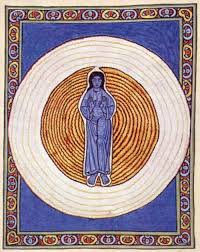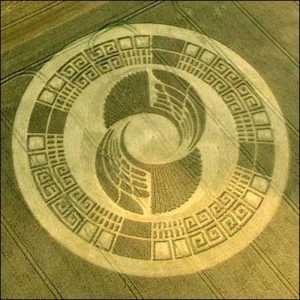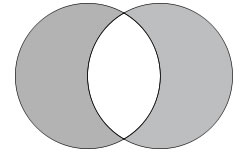I’m in the midst of a creative explosion again. This time it’s taking me into the study of sacred geometry. But I notice I’m open to almost any subject – the breath, life at a macroscopic level, life at a microscopic level. For a humanist, these are decidedly new interests.
You have to know that I’m a person with no particular love for mathematics, no head for numbers. I did have a past life as a mathematician, who apparently said to Michael at the end, “Please don’t ask me to study mathematics again,” to which he agreed.
However I’ve also studied the Biblical code, which is replete with symbols, for years. And I also know that my gift has always been pattern recognition.
Some deep, inner thirst for the subject of sacred shapes has been awakened. And I’d like to illustrate how that new interest is manifesting and what it’s producing.
Consider the Vesica Piscis, whose study I’ve been drawn to. (1) The plain vanilla Vesica is given in the diagram to the right; when we draw straight lines through all centers and points of intersection, the elaborated version is produced, below, left.
People talk about the Vesica Piscis in two ways. Some may say that it’s the figure formed when two circles of equal radius intersect each other, such that the circumferences of both touch the center of the other.
Or they may say that Vesica Piscis refers only to the almond-shaped central area, shared by both circles in common.
Besides signifying the equality of the two objects in relationship, the Vesica is often used to speak to the relationship of the Holy Father and Divine Mother. It illustrates that they’re equal and have similarities and differences. They share the fact that both are the Transcendental, the Highest Reality, the Source of all that is, the One.

Shakti dancing on the recumbent body of Shiva: the Mother is active; the Father is still
They differ in that the Father is silent and still and the Mother is sonic and active. It is she who creates, preserves and transforms all that we see around us. He doesn’t lift a finger or move a muscle, so to speak. That’s why Shakti is depicted as dancing on Shiva’s recumbent body (see figure, right). It’s she who dances the universes into being.
Alternatively, the Vesica is used to illustrate the offspring of the Divine Couple. There the almond-shaped common area is represented as being the Divine Child. In this interpretation, the Father is the Transcendental; the Mother is the Material; and the Child is the Transcendental in the Material.
The relationship between the Divine Father, Mother and Child does not have to be illustrated using the Vesica Piscis. Hildegaard of Bingen, as we discussed in an earlier article, (2) used non-intersecting circles to illustrate that relationship (see figure, below, left).
 If the Transcendental Father is grey and the Phenomenal Mother is brown, then notice that the Divine Child is suspended in the brown but retains its nature as the grey. This exactly reflects the relationship between the Divine Child and its Mother and Father, at the phenomenal level.
If the Transcendental Father is grey and the Phenomenal Mother is brown, then notice that the Divine Child is suspended in the brown but retains its nature as the grey. This exactly reflects the relationship between the Divine Child and its Mother and Father, at the phenomenal level.
The three figures of the Trinity are known to Christians as the Father, Son, and Holy Ghost and to Hindus as Brahman, Atman, and Shakti.
Whether we contemplate a symbol such as the Vesica Piscis or an alternative version such as Hildegaard’s, the usefulness of them is that they help us visualize, and thereby become comfortable with, the relationships that exist at the highest levels of Reality. Doing so contributes to accomplishing the purpose of life (to realize our true divine nature).
Tomorrow I’d like to conclude by giving my own interpretation of the Vesica Piscis.
Footnotes
(1) Some call it the Vesica Pisces. “Pisces” is plural for “piscis.”
(2) See “The Journey of Life” at https://goldenageofgaia.com/2015/10/29/the-journey-of-life/.




